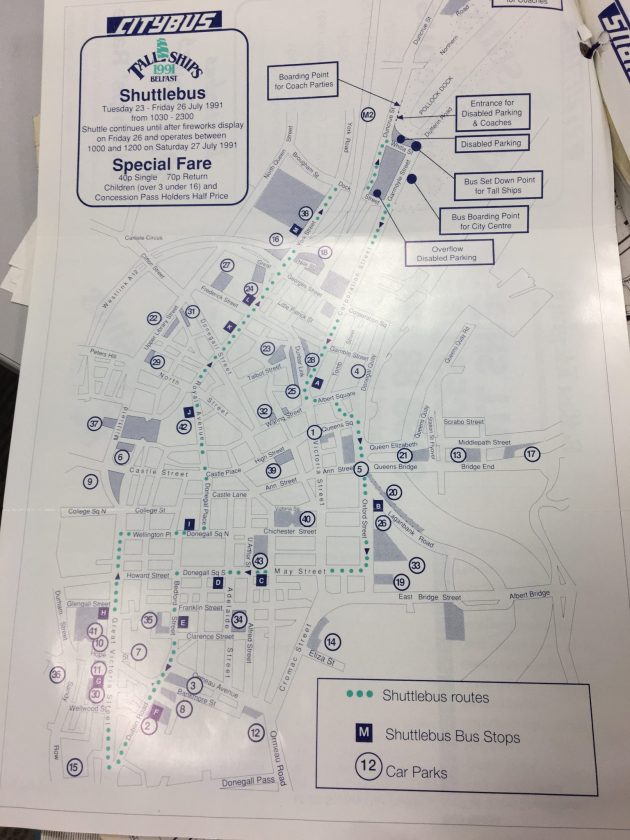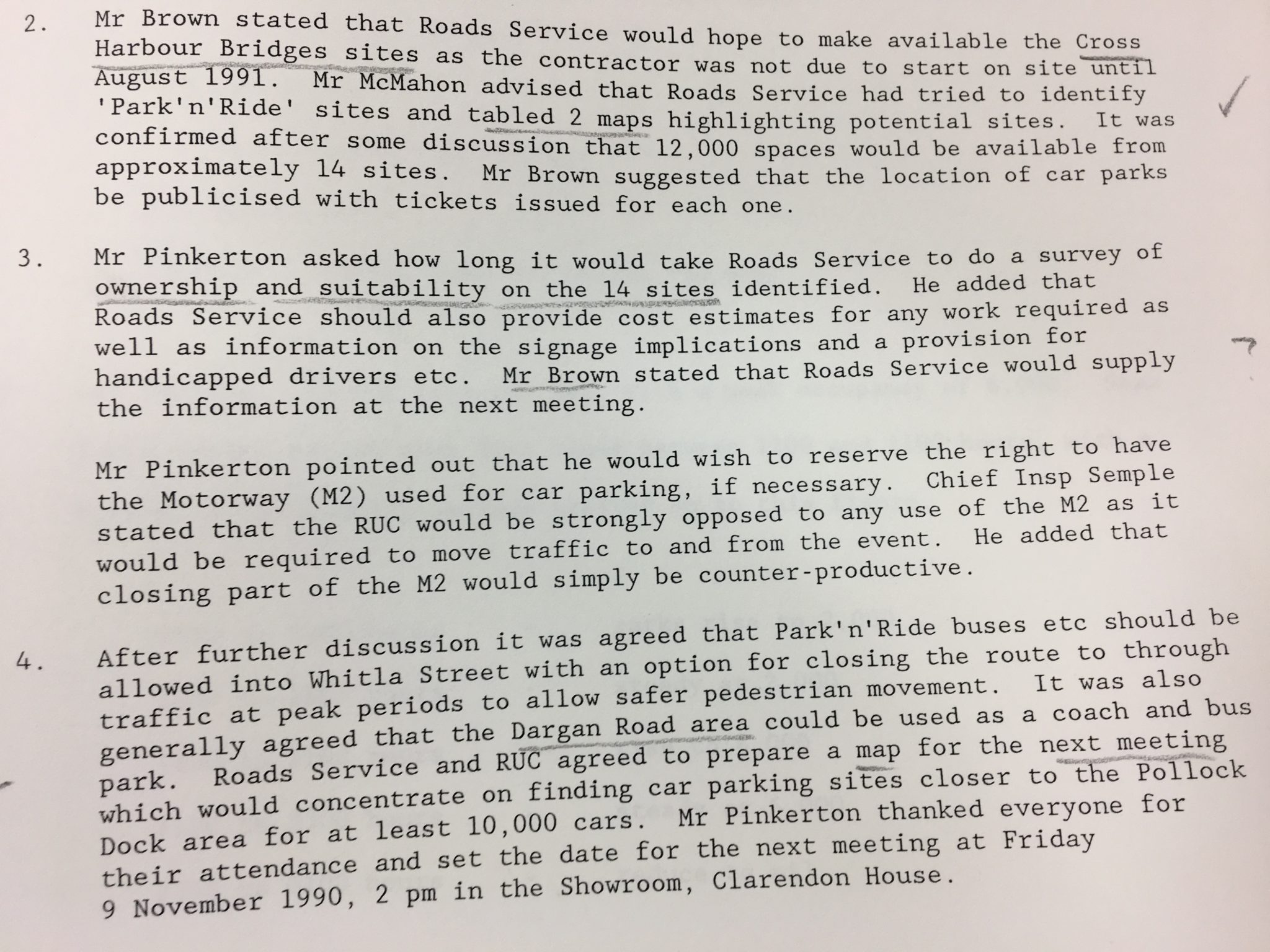 The Tall Ships first visited Belfast between 23-27 July 1991, with US broadcaster Walter Cronkite sent over to cover the story as well as the BBC’s Harry Secombe. The Balmoral Show and Ideal Home Exhibition were probably the largest events in Northern Ireland at that time.
The Tall Ships first visited Belfast between 23-27 July 1991, with US broadcaster Walter Cronkite sent over to cover the story as well as the BBC’s Harry Secombe. The Balmoral Show and Ideal Home Exhibition were probably the largest events in Northern Ireland at that time.
The then Junior Minister, Richard Needham, saw the maritime festival as an opportunity to “show the world there was another side to Belfast”. It also attracted many local people back into Belfast city centre after years of avoiding it during the height of the Troubles.
A week or so ago I spent a couple of hours in the Public Records Office reading through a government file ENV/45/1 [selective scans] about preparations for the Tall Ships event while previewing the papers released last Friday under the 30/20 Year Rule. It brought back memories of being taken as a teenager to the undeveloped Belfast Harbour area for the first time and pushing through the throngs as we walked up the long quayside to look at the sailing ships.
I spoke to the former Northern Ireland Minister Sir Richard Needham last night and he described the summer 1991 Tall Ships event as the culmination of a year long programme of events to “celebrate the rebirth of Belfast”.
He’d inherited a regeneration plan from his predecessor Chris Patten, and the strategic concept was to redevelop Belfast and make it “modern, exciting, well designed, centre”. Richard Needham used to quip that the plan was to “get everybody to come and work in the city centre, shop in the city centre, eat in the city centre and then go home and make love to each other”.
“It was to create a place of hope and expectation and quality and to give people a feeling of pride in their city which went back a 100 years to the incredible city Belfast was in the Victorian era.”
As an event, the Tall Ships was “totally cross-community, cross sectarian, and also to bring the fact to the eyes of the world that Belfast was now a much more normal and happy and successful place than it had been.”
While the Tall Ships organisation was at first reluctant to come to troubled Belfast, it helped that the organisation’s chairman Lord Burnham was Richard Needham’s cousin as “blood is thicker than water” (Burnham’s words, not the Minister’s).
At the end of four days with “perfect” weather, he recalls watching the Parade of Sail from the North Down side of Belfast Lough “and you could see the people coming down the Shankill, coming down the Falls, coming down from the Markets, all pouring into it – it was wonderful, absolutely wonderful.
It was “probably the standout moment” in his time serving in Northern Ireland “because people could see that Belfast was on the way back”. Further reflections can be found in his book, Battling the Peace.
 In the twelve months leading up to the summer 1991 event, the ENV/45/1 file shows a Department of Environment team frantically tried to identify 5,000-10,000 extra parking spaces which were expected to be needed for visitors.
In the twelve months leading up to the summer 1991 event, the ENV/45/1 file shows a Department of Environment team frantically tried to identify 5,000-10,000 extra parking spaces which were expected to be needed for visitors.
Back in August 1990 the expectation was that 200,000 car borne visitors over 4 days at 4 per car, so 12,000 extra cars per day should be expected near the Dock area. (Newcastle upon Tyne modelled with just 3 people per car.) An M2 tailback of a mile was anticipated throughout the period.
Owners of public and private sites around Belfast were contacted for permission to use their land to operate temporary car parks. Many of those asked responded negatively, supplying difficult-to-believe excuses for why their land would be unavailable the following summer. The traffic management plan from Newcastle Upon Tyne in 1986 was examined.
In September 1990, the chair of the Belfast Development Office Mr W Pinkerton described the 1991 Tall Ships Visit to Belfast in 1991 as “a once in a life-time event of great spectacularity”!
He was bullish in his insistence that traffic management and parking was taken seriously. In an October meeting he said that he reserved the right to “have the Motorway (M2) used for car parking, if necessary”.
The RUC’s Chief Inspector Semple called this suggestion “counter-productive” stated that “the RUC would be strongly opposed to any use of the M2 as it would be required to move traffic to and from the event”.
By November, park and ride locations as far out as Ulster University’s Jordanstown playing fields were being considered.
 Ove Arup advised that temporary carparks proposed for the North Foreshore would have to consider the risk of landfill gas and recommended “a wise precaution to ensure that any temporary buildings (eg control or refreshment kiosks) are raised on plinths about the ground to ensure adequate through ventilation beneath the building”.
Ove Arup advised that temporary carparks proposed for the North Foreshore would have to consider the risk of landfill gas and recommended “a wise precaution to ensure that any temporary buildings (eg control or refreshment kiosks) are raised on plinths about the ground to ensure adequate through ventilation beneath the building”.
“It may also be prudent to prohibit naked flames on the site, though we don’t feel this is essential.”
 By May 1991 plans were in an advanced state with a “single circular bus route” agreed, taking up an RUC Inspector’s suggestion “that the route should take in the most scenic aspects of the City Centre”. Important optics for people returning to a slowly regenerating Belfast after a long absence.
By May 1991 plans were in an advanced state with a “single circular bus route” agreed, taking up an RUC Inspector’s suggestion “that the route should take in the most scenic aspects of the City Centre”. Important optics for people returning to a slowly regenerating Belfast after a long absence.
 By June 1991, Sea Cadets or Scouts were being suggested to mark out lines or “shape” some of the temporary car parks. One of the sponsors Dalgety threw a spanner in the works by proposing to erect a marquee for corporate entertainment in the Disabled Car Park. Officials noted that they didn’t have “any cards which we can play”.
By June 1991, Sea Cadets or Scouts were being suggested to mark out lines or “shape” some of the temporary car parks. One of the sponsors Dalgety threw a spanner in the works by proposing to erect a marquee for corporate entertainment in the Disabled Car Park. Officials noted that they didn’t have “any cards which we can play”.
Some of the final papers to be added to the file that is dominated by parking and signage tell the story of a human tragedy which occurred at the end of the festival which brought an estimated 500,000 visitors to the harbour area.
Having set out to watch the final Parade of Sail with his son and grand-children, a man died. His medically-qualified daughter-in-law Dr Stewart wrote to the Minister to complain about the traffic congestion that meant neither she nor the emergency services could reach the ill man in time for “resuscitative intervention”.
The file contains a briefing note written for the Minister’s Private Secretary which states:
“The NI Tall Ships Council and The Hon T Robin Dixon in particular went to endless lengths to persuade the RUC and Roads Service of the need for thorough traffic management arrangements for the Parade of Sail … we knew the traffic would be excessive. The RUC and Roads Service responded to those promptings but even with contingencies the arrangements were overwhelmed.”
The internal correspondence advised that “the Minister should confine his response to one of sympathy and regret that the traffic managements [sic] arrangements were overwhelmed with such disastrous results” but stressed that he “should avoid any comment which could be interpreted as accepting liability”.
Having been consulted about the incident, the RUC “concluded that everything which could have been done had been done”.
Traffic management plans around big events in NI have matured greatly since 1991. As the Orange Order paraded up the Lisburn Road on the Twelfth of July, marshals were able to quickly stop the parade and move it to one side of the road to make space for an ambulance to travel down the road against the flow of the parade to rush someone to hospital.
While freak weather can still bring Belfast city centre roads to an unexpected standstill, Dr Stewart’s letter is a reminder that we expect blue light services to continue working no matter the circumstance.
While the ENV/45/1 file is not the final word on the traffic management for the Tall Ships event, the minutes of meetings recorded much more discussion of parking and signage than holding the RUC to account for their detailed plans to manage the expected congestion and to expedite the movement of emergency vehicles.
Nor is the file the final word on the outcome of the Tall Ships event. Sitting in the PRONI catalogue there is likely to be a corresponding Department of Economic Development file that deals with the economic regeneration, and others too that detail the evaluation of this enormous event that built the foundation upon which a host of high profile events (and return visits by the Tall Ships) have been built.
Alan Meban. Tweets as @alaninbelfast. Blogs about cinema and theatre over at Alan in Belfast. A freelancer who writes about, reports from, live-tweets and live-streams civic, academic and political events and conferences. He delivers social media training/coaching; produces podcasts and radio programmes; is a FactCheckNI director; a member of Ofcom’s Advisory Committee for Northern Ireland; and a member of the Corrymeela Community.
Discover more from Slugger O'Toole
Subscribe to get the latest posts to your email.

